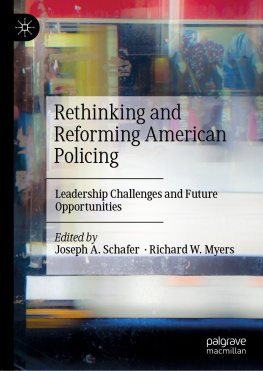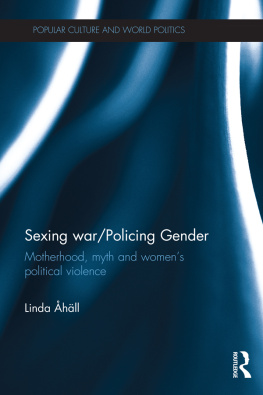Gender and policing
Gender and policing
Sex, power and police culture
Louise Westmarland
First published by Willan Publishing 2001
This edition published by Routledge 2011
2 Park Square, Milton Park, Abingdon, Oxon OX14 4RN
711 Third Avenue, New York, NY 10017
Routledge is an imprint of the Taylor & Francis Group
Louise Westmarland 2001
The right of Louise Westmarland to be identified as author of this work has been asserted by her in accordance with the Copyright, Designs and Patents Act of 1988.
All rights reserved; no part of this publication may be reproduced, stored in a retrieval system, or transmitted in any form or by any means, electronic, mechanical, photocopying, recording or otherwise without the prior written permission of the Publishers or a licence permitting copying in the UK issued by the Copyright Licensing Agency Ltd, 90 Tottenham Court Road, London W1P 9HE.
First published 2001
ISBN-10 1-903240-70-0
ISBN-13 978-1-903240-70-0
British Library Cataloguing-in-Publication Data
A catalogue record for this book is available from the British Library
Contents
List of Tables
Preface and acknowledgements
This book draws upon and updates research originally conducted for a doctoral thesis and without the help and support of a number of people during that process, it would not have been achieved. Dick Hobbs, as my PhD supervisor, was a constant source of advice, guidance and inspiration. He not only said that his door was always open, but that I should regard him as the last stop before the Samaritans. Other members of staff at Durham who also provided invaluable support include Dave Chaney, Nick Ellison, John Tierney and Robin Williams. During my time at York, whilst the writing process of the book was continued, Anne Ackroyd, John Forrester and Steve Yearley, amongst others, helped by providing bibliographic references and opportunities for work, rest and play.
In addition, several people discussed and commented upon conference papers, articles and chapters in draft, including Richard Collier, Simon Blyth, Jennifer Brown, Sandra Walklate, Jim Sheptycki, Dave Wall, Adam Crawford and Malcolm Young. Betsy Stanko provided useful advice by suggesting a number of changes to the original format of the book and I would also like to thank Laurie Taylor for constantly asking me when it would be finished, in addition to giving me the confidence to think it ever would. Brian Willan has helped in the final stages of preparation of the manuscript, and without the cooperation of the two police forces that provided access, the research would not have even begun. Thanks are due to the many officers who gave freely of their time, opinions and in some cases friendship during the fieldwork, especially Elaine Taylor, Stephanie Yearnshire and Brian Douglas.
Finally, I would like to thank my family, for supporting me in many different ways for the duration of my academic career so far, and my colleagues at the Scarman Centre, including Rosemary Barberet, Tina Skinner and Chris Wilkinson. Most of all, thanks to Keith for being a great friend and debating partner.
Louise Westmarland
November 2001
Chapter 1
Policing and gendered bodies
Police officers embody the authority of the state and are afforded certain powers with which they are expected to preserve the peace, maintain social and political order and fight crime. To carry out these functions they wear a uniform and carry certain tools of the trade such as handcuffs and truncheons, symbolising their legitimate right to use force. In carrying out their duties it is expected that bodily strength may have to be used to facilitate certain tasks. Despite the potentially physical nature of these activities and the increasing popularity of the study of the human self as an embodied agent (Turner, 1996:6) however, it seems that the police have not been analysed in terms of the body. Indeed, there appears to be a significant lack of empirical research to complement the growing number of theoretical studies concerned with embodiment and gender, such as Bordo (1997), Davis (1996), Hausman (1995), Mackenzie (1998) and Scott (1997). Lived experiences of men and women in the police, acknowledging differences in the ways they are embodied, have been ignored to date. This book will explore connections between police culture and the significance of gendered bodies on the street and throughout various specialist departments. To support this analysis, extensive ethnographic data are provided which illustrate the way force and strength are used as officers contract in with their bodies, or choose to withdraw from certain encounters. Indeed, as personal and professional status in the police is largely dependent upon showing bottle, choices concerning the use of their physicality are especially significant to our understanding of police work. In effect, the way gendered bodies create a situation which perpetuates beliefs about certain occupational roles being designated either male or female is explored. Similarly, gendered identities, which take genitalia to be the definitive sign of sex essential to the symbolisation of reproductive sexuality (Butler, 1990:109-10) will be explored. One of the ways this will be carried out is by analysing masculinity and femininity as a requirement in different fields of policing, through an examination of how the police deal with child abuse, domestic violence and sexual offences.
As a result of bringing the body back in (Frank, 1990), therefore, this study analyses two interdependent areas of contention, the first of which is the debate surrounding differential deployment and gender. Since the official integration of women officers into the main police organisation there have been discussions about what they are actually doing in the police, what they should be doing, and how efficiently they are doing it. In the past this discussion has tended to be within the context of what Heidensohn describes as the Is it working? approach (1995:104), which has examined the often fragmented and ineffectual organisational policies designed to create equality of opportunity for women officers (see for example, Jones, 1986, Anderson, Brown and Campbell, 1993). In terms of the force and strength element of this debate, however, which usually reflects upon whether women are physically capable of carrying out the policing mandate, personal autonomy and the body as a representation of the gendered self seem to have been disregarded. As Walklate argues, there has been an absence of a debate around policing as a gendered task (2001:149), leading to policewomen finding themselves in ambiguous positions regarding their careers. As specialists, simply by merit of being women, they are encouraged to work in departments dealing with supposedly gendered issues such as domestic violence, and may feel that this is where their talents can be used to provide the best possible service for the abused. Due to normative social and cultural expectations, the issue of embodiment has been ignored here too, although many of the tasks officers are required to carry out in their specialisms are linked to gendered bodies and their erotic and sexual identities. As authors of works on the body and sexuality have suggested, these issues are now believed to be more intimately connected than previously presumed (Pringle, 1992, Butler, 1997, Halford, Savage and Witz, 1997). Similarly, in policing, occupational roles are constructed due to assumptions about embodied expertise, such as the ability to care for children due to being able to give birth, or the ability to fight due to some aspect of male strength. Hence, this study uses the gendered body to illustrate the way force and anatomy are determinants of competence in the police.





